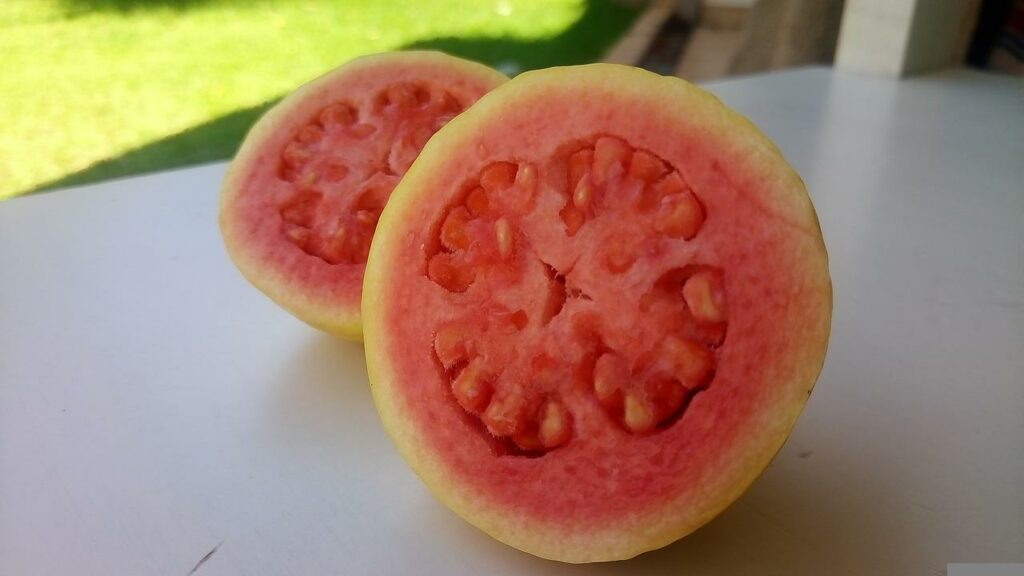10 Different Types of Guavas (With Pictures)
-
Codee Chessher
- Last updated:

Guavas are typically pear-like fruits prized for their exotic taste and are grown in tropical regions worldwide. Most people are probably familiar with one or two types of guavas, but there are numerous others you’re missing out on. Let’s dive into the world of guava and see what makes each type deliciously unique.
The 10 Different Types of Guavas
1. Strawberry Guava

| Native to: | Brazil |
| Color: | Red |
Sometimes called the cherry guava, this iconic fruit is native to Brazil but was brought to Hawaii in the early 19th century. Unlike most guavas, this fruit has smooth red skin and similarly red flesh inside. The flavor is said to be akin to strawberries combined with roses, which is where the name came from. Strawberry guava is generally grown in tropical regions.
2. Lemon Guava

| Native to: | Brazil |
| Color: | Yellow |
Lemon guava is a unique guava with a strong lemony taste that makes it perfect for jams and jellies or eaten raw. The bumpy yellow skin peels open to reveal shockingly pink, tart flesh. Although native to tropical Brazil, lemon guava is best grown in subtropical climates. These fruits are also known for their pretty white flowers and small plant size.
3. Tropical White Guava

| Native to: | Mexico |
| Color: | White |
Hailing from Southern Mexico, the tropical white guava is widely grown in tropical zones across Asia and Africa. The fruit has the trademark bumpy skin of guava, but the yellow-green skin belies the creamy white fruit within. Tropical white guava trees also do well in subtropical climates and are fairly easy to grow yourself.
4. Pineapple Guava

| Native to: | Brazil |
| Color: | Yellow or green |
With flesh like a pineapple, pineapple guava is an apt name. The skin is a typical guava green, and the fruit grows alongside an edible white and purple flower. Pineapple guavas are notable for their versatility—they can be eaten raw, cooked into desserts, cut into fruit salads, and turned into jelly or jam. These come from Brazil but are now grown all over Central America.
5. Red Indian Guava

| Native to: | Florida |
| Color: | Red or pink |
Strangely enough, the Red Indian Guava is not native to India. Rather, it was created in Dade County, Florida! When cut in half, the fruit looks like a grapefruit with yellow skin and bold pink flesh. However, it has many seeds like a watermelon. It’s a great snack raw or chilled in the fridge.
6. Vietnamese Guava

| Native to: | Vietnam |
| Color: | Green |
Also called giant guava, Vietnamese guava is a primary source of guava juice worldwide because of its huge size. In appearance, they look like giant, bumpy pears. The green flesh parts to show a creamy white flesh that’s also great for snacking or blending into smoothies. Like many guavas, these are packed with lots of essential nutrients and minerals.
7. Detwiler Guava

| Native to: | Central America |
| Color: | Yellow |
A specialty from Central America, the detwiler guava is the only known guava with yellow flesh. It varies more than any other guava in appearance, but all varieties have mildly sweet yellow flesh and firm, bumpy skin. If something says it has guava in it, chances are that it has this widely eaten fruit in it.
8. Sweet White Indonesian Guava

| Native to: | Indonesia |
| Color: | White |
Yet another pear-like guava, the sweet white Indonesian is actually native to Indonesia. These trees are great for agriculture because they produce many large green fruits with flavorful pink flesh. The main caveat is that they take a rather long time to grow compared to other guavas, so they may not be as fruitful.
9. Hong Kong Guava

| Native to: | Thailand |
| Color: | Pink |
Also called pink guava, Hong Kong guava are actually native to nearby Thailand. They grow up to 8 ounces per fruit, with watermelon-like pink flesh. Because they have few seeds compared to most guavas, Hong Kong guava is perfect for blending into juices, smoothies, and crafting jellies or desserts.
10. Yellow Cherry Guava

| Native to: | Peru |
| Color: | Yellow |
Not to be confused with the cherry or strawberry guava, this compact fruit hails from Southeastern Peru. These are the most laid-back, low-maintenance guavas on our list, and most people can grow them at home. Keep in mind that you’ll harvest many small fruits, so you’d better have plans for them! We’d suggest snacking on them raw or chilled.
Conclusion
Guavas are one of the tastiest exotic fruits, hailing from many regions around the globe. They’re all delicious, but different types of guavas have different flavors. Make it a goal to try as many types of guavas as possible, using this article as a guide!
Featured Image Credit: jameertamboli786, Pixabay
Contents
